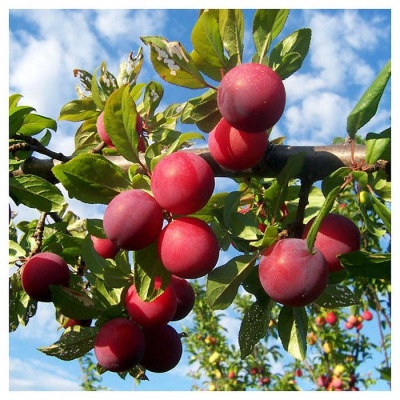
- Authors: Czech
- Year of approval: 1947
- Growth type: vigorous
- Crown: round-oval, medium density
- Tree height, m: until 6
- Fruit size: large
- Fruit weight, g: 38
- Fruit shape: rounded
- Fruit color: main - light green, integumentary - pink-red, completely covering the entire fruit; thick wax coating
- Skin : no pubescence, thin, dense, easy to remove, loose consistency
To enjoy delicious and aromatic plums every summer, it is enough to plant a classic plum tree in your summer cottage, which will bear fruit well. The most suitable, especially for beginner summer residents, will be the early plum variety Renklod Altana of Czech selection.
Breeding history
Renclode Altana is the result of the efforts of Czech breeders. The plum was removed from the seeds of the Green Renklode culture. A fruit crop appeared in the State Register in 1947. The variety is zoned in the North Caucasian and Lower Volga regions. The variety has another name - Purple round.
Description of the variety
Plum Renclode Altana is a vigorous tree with an oval-rounded crown. In a favorable climate, the tree grows up to 6 meters in height. He has a moderately thickened crown with dark green foliage with a glossy surface, erect thickened shoots with a brown-purple bark color, spreading branches and a developed root system.
Flowering begins in the second half of April. At this time, the crown of the tree is literally covered with small snow-white flowers-bells, which emit a pleasant aroma.
Fruit characteristics
Plum belongs to the category of large-fruited crops. On a healthy tree, fruits grow on average 38 grams. The shape of the plums is correct - rounded with a smooth surface and a gray waxy bloom. Ripe plums have a beautiful color - light green, diluted with a pink-red blush almost over the entire surface. The peel of the plums is thin, but strong, covered with small brown subcutaneous punctures. The abdominal suture of the fetus is barely visible.
Plums are characterized by good transportability and long shelf life (up to two weeks). The maximum long-term storage without loss of taste and marketability is observed in plums harvested slightly unripe. You need to store the fruits in a wooden or plastic container.
The purpose of fruits is universal - they are eaten fresh, canned, processed into jams, preserves, marmalades, compotes, and also frozen.
Taste qualities
Renclaude Altana is famous for its excellent taste. The yellowish flesh has a moderately dense, tender and juicy texture. The fruit has a balanced taste - sweet and sour, without bitterness and astringency. The stone is medium-sized, easily separated from the pulp. The pulp contains more than 10% sugars and 1% acids.
Ripening and fruiting
This type of plum represents a class of medium-ripening varieties. The tree bears fruit in the 4-5th year after planting. Plums ripen gradually, so the fruiting period is somewhat extended. The tasting period starts in mid-August and lasts for several weeks (until early September).

Yield
Plum is highly productive. Yields depend on the age of the tree. On average, one tree produces 20-35 kg of fruit per season. 35-40 kg are removed from a 7-8 year old tree, and a plum over 12-15 years old gives up to 90 kg.
Self-fertility and the need for pollination
Renclode Altana is a self-fertile species, therefore, an increase in the number of ovaries is indispensable. This is facilitated by additional cross-pollination. It is possible to pollinate trees artificially, but it is better to plant donor trees on the site, blooming at the same time as this plum variety. The optimal pollinating trees for the Renclaude Altana plum will be: Victoria, Kirke, Mirabel, Nancy, Italian Hungarian, Anna Shpet.
Growing and care
Planting of seedlings is carried out both in spring (April) and in autumn (second half of September). The agricultural technology of the culture is simple, but the soil and the site should be selected carefully. Plum loves fertile, loose and breathable soils without moisture stagnation. The site must be sufficiently illuminated by the sun and protected from strong winds.
Caring for a fruit tree includes regular watering, fertilization, sanitary pruning of branches, crown formation, loosening and mulching of the soil, protection from insects and viruses, as well as from rodent infestations.
In addition, trees must be prepared for winter - whitewashing, protection of the root system by covering with special materials. One / two-year-old trees need special protection, which must be completely wrapped with agrofibre or burlap.




Disease and pest resistance
The tree is distinguished by high immunity, due to which it practically does not undergo fungal diseases, and is also resistant to clasterosporia, sharke and polystygmosis. Most often, the plum is sick with moniliosis. Among the pests, the most dangerous are: plum moth, aphid, shoot moth.

Despite the fact that plum is considered more hardy than many fruit trees, it is not immune from diseases. It is attacked by viral, fungal and bacterial infections, and parasitic insects harm it. It is necessary to notice and recognize the signs of plum disease in time. They are easier to deal with and defeat early on. Well, in order to protect the garden tree from such a misfortune in the future, preventive procedures can be carried out.
Resistance to soil and climatic conditions
Due to its resistance to stress, the fruit crop easily tolerates frosts, temperature fluctuations, short drought and extreme heat. Excessive moisture and dampness negatively affect the development of a fruit tree.



































































